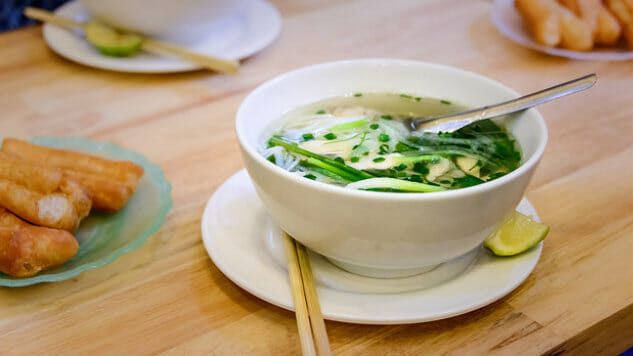Why You Should Care About the Bon Appetit Pho Uproar

It’s been said that history is written by the winners. In that case, is it possible that the dominant voices of food media are the winners of cultural food wars, and that social media is changing that landscape dramatically?
On September 6, BonAppetit.com published a since-removed video called “Pho Is the New Ramen” and accompanied it with the headline “PSA: How to Eat Pho.” Instructional videos are common in the food world, but this one had a catch. In the video, Stock Philadelphia owner Tyler Akin proclaimed that he never taints his Vietnamese soup with sauce, warning viewers that if they did so, they’d be committing a mortal sin against the chef. “If the cook, or the chef, or the owner, or whoever, sees you dump your hoisin or your Sriracha in the soup before tasting the broth, it’s like, it hurts,” Akin said mournfully.
The fact that this throwdown of the authoritarian gauntlet came from a non-Vietnamese-American chef who owned a restaurant that very generally described itself as “southeast Asian” (and casually played host to both Thai and Vietnamese flavors) — well, it didn’t bode well for him as an authority of authenticity. The Facebook stratosphere soon lit up with comments.
“Pho is the new ramen? You mean you don’t put sauce in your broth? There’s no tendon, flank, or intestines?? When Asian food becomes hipster, all authenticity is lost,” one commenter wrote. Respected Vietnamese-American food writer, cookbook author and cooking teacher Andrea Nguyen, who has written about the North-South divide in Vietnam’s taste for saucy pho, posted on her blog about why the video’s premise was problematic, while Sriracha-loving commenters who had grown up eating pho posted their grievances. The title was soon changed to “We Love This Pho.”
In its print version, Bon Appetit mistakenly attributed lemongrass as one of pho’s ingredients. And in an especially cringeworthy ending to the video, Akin taught Bon Appetit viewers his chopstick technique of twirling noodles around the ends of both chopsticks like spaghetti noodles around a fork, and Bon Appetit confusingly declared it “a simple twirling technique that’s a little bit mind-blowing” due to its being “a chopstick technique that leaves you with a substantial group of noodles, instead of picking and slurping your noodles one by one.”
Yours truly was confused by this statement because I’ve never had just a single noodle on my chopsticks, maybe since childhood. My mother would probably flay me alive for eating my noodles too slowly, which allowed them to bloat. Perhaps Bon Appetit meant that using chopsticks is hard for those who are not accustomed, and twirling would help the unaccustomed ensnare more noodles, but this statement seemed to leave Asian-American pals of mine (and anyone else who has been using chopsticks since childhood) just plain confused. Why would we do this, I wondered, when slurping the hell out of your freshly-dunked noodles is efficient, delicious, and a favorite family competition?
After social media went wild, the video was taken down and an apology was offered. A slew of articles about appropriation popped up online on Cosmo.com, Mic, First We Feast and Mediaite. As is the case with many media flaps, the conversation that comes after a controversy can often be more important to a cultural conversation than the controversy itself.
You might be asking yourself why food matters in the grand scheme of anything beyond nourishment and enjoyment, or in the grand scheme of anything political at all. Cathy Erway has written thoughtfully about this topic in her Civil Eats piece “Beyond Talk: Real Solutions for Food Appropriation.” For instance, she writes about how Gullah cuisine has been used — and some say, appropriated — by celebrity chefs like Sean Brock, who are often featured on TV shows that only amplify their fame — and, consequently, their paychecks.
Thinking about food and cultural appropriation is extremely challenging. Many of us would prefer to think of food in terms of our warmest memories of love and nurturing; those memories are housed in areas of our brain that trigger warmth, happiness, holidays and relaxing. But clearly, from the perspective of those whose food, namely pho, was largely ignored by mainstream food media until being declared a media darling and a “new” “it food” — ignoring the issues of appropriation is not always so easy.
For starters, there’s the mere taste aspect of food, as in — what is delicious? And then there’s the matter of considering history and context. I recently judged a taco competition, and the judges were split on taco results. The owner of one taco shop and I were dead set on the most delicious, regardless of authenticity. The proof is in the pudding, we declared. Another owner of a taco shop agreed that our picks were delicious, but that they had not been made from scratch, using time-worn Mexican methods, or with Mexican ingredients. In the end, the judges reached a compromise that awarded both taste and from-scratch authenticity.
The word authenticity has always rankled me. Authentic is a questionable word, considering the fact that my favorite “Korean” dish growing up was one brought about by the Japanese occupation of Korea, and that my favorite taco is one that Lebanese immigrants supposedly brought to Mexico. Al pastor is known for its sliced pineapple topping, but if someone started topping it with some crazy grilled peach concoction and it was damn good, I’d be the first one in line every day. Tradition is important to me, but innovation in favor of deliciousness is even more important to me.
-

-

-

-

-

-

-

-

-

-

-

-

-

-

-

-

-

-

-

-

-

-

-

-

-

-

-

-

-

-

-

-

-

-

-

-

-

-

-

-








































